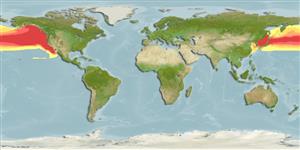>
Aulopiformes (Grinners) >
Notosudidae (Waryfishes)
Etymology: Scopelosaurus: Greek, skopelos = a lantern fish + Greek, sauros = lizard (Ref. 45335); harryi: Named after R.R. Harry, U.S. ichthyologist (Ref. 6885).
Environment: milieu / climate zone / depth range / distribution range
Ecología
marino batipelágico; rango de profundidad 0 - 1500 m (Ref. 50550), usually 200 - 800 m (Ref. 43939). Deep-water; 60°N - 20°N, 121°E - 110°W
North Pacific: off Japan, throughout the California Current region (Ref. 35934) to the Aleutian Islands (Ref. 265); including Sea of Okhotsk and Bering Sea (Ref. 43939).
Tamaño / Peso / Age
Maturity: Lm ? range ? - ? cm
Max length : 32.0 cm SL macho / no sexado; (Ref. 43939)
Espinas dorsales (total): 0; Radios blandos dorsales (total): 10-12; Espinas anales 0; Radios blandos anales: 16 - 19; Vértebra: 58 - 61. Adipose fin small (Ref. 6885). Dark on head, body and fins; peritoneum, gills, and mouth cavity black (Ref. 6885). Branchiostegal rays: 10 (Ref. 35934).
Larger individuals apparently occur in deeper water than small ones (Ref. 4525). Synchronous hermaphrodites (Ref. 35934). Oviparous, with planktonic larvae (Ref. 35934). Juveniles makes nocturnal vertical migrations to the epipelagic zone (Ref. 43939). A planktivorous fish feeding mainly copepods and euphausiids (Ref. 35945).
Life cycle and mating behavior
Madurez | Reproducción | Puesta | Huevos | Fecundidad | Larva
Eschmeyer, W.N., E.S. Herald and H. Hammann, 1983. A field guide to Pacific coast fishes of North America. Boston (MA, USA): Houghton Mifflin Company. xii+336 p. (Ref. 2850)
IUCN Red List Status (Ref. 130435)
Threat to humans
Harmless
Human uses
Más información
ReferenciasAcuiculturaPerfil de acuiculturaRazasGenéticaElectrophoresesheritabilidadEnfermedadesProcesamientoNutrientsMass conversion
ColaboradoresImágenesStamps, Coins Misc.SonidosCiguateraVelocidadTipo de nataciónSuperficie branquialOtolitosCerebrosVisión
Herramientas
Special reports
Download XML
Fuentes de Internet
Estimates based on models
Preferred temperature (Ref.
123201): 0.3 - 7.2, mean 3.4 °C (based on 266 cells).
Phylogenetic diversity index (Ref.
82804): PD
50 = 0.5001 [Uniqueness, from 0.5 = low to 2.0 = high].
Bayesian length-weight: a=0.00288 (0.00120 - 0.00692), b=3.18 (2.96 - 3.40), in cm total length, based on LWR estimates for this (Sub)family-body shape (Ref.
93245).
Nivel trófico (Ref.
69278): 3.1 ±0.0 se; based on diet studies.
Resiliencia (Ref.
120179): Bajo, población duplicada en un tiempo mínimo de 4.5-14 años (Assuming tmax>10).
Fishing Vulnerability (Ref.
59153): Low to moderate vulnerability (29 of 100).
